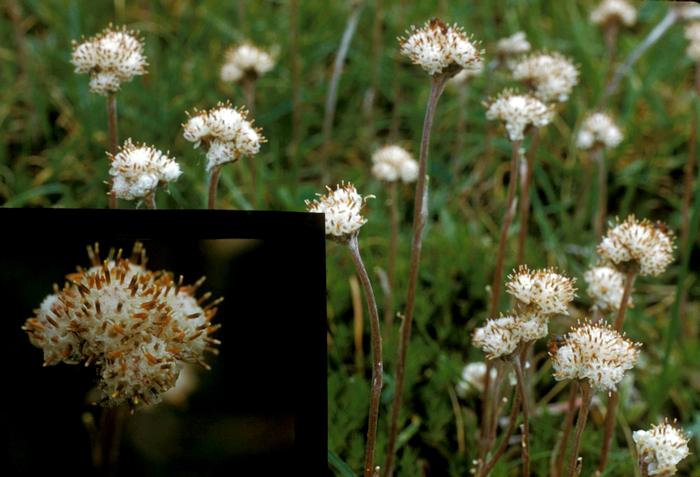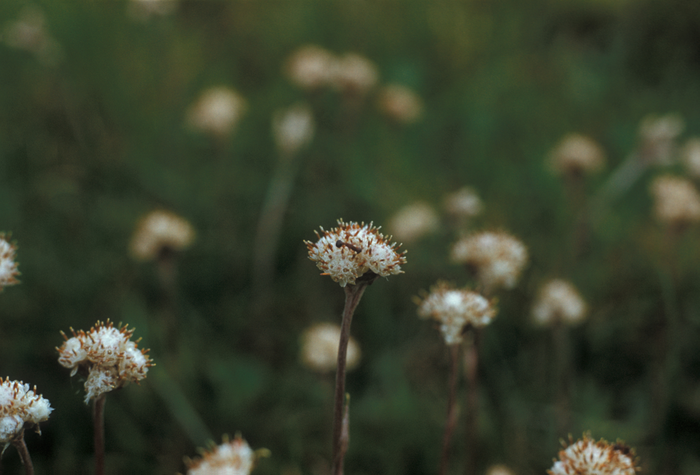General Description
Bloom Description: Blooms May to June. Flowers are white and in little bundles like a cat's toes, on stalks usually less the 12" high.
Growth Habit & Shape: Foliage creeps along the ground by stolon and creates slowly expanding patches that fill spaces between larger plants. Can spread slowly by seed when seed lands directly on soil.
Soil Preferences: Often found in poor, dry, sandy, or gravelly soils. It can adapt to a wide range of soils and soil pH's, but does not do well in poorly drained or compacted conditions.
Root Description: New roots grow from above ground runners (stolons).
Garden Uses: Ideal component of shorter plantings in dry, sunny, or part shade conditions. Can do well in shade, particularly if the spot is dry and leaf litter is light, like a North-facing slope in an open woods. Thrives in light leaf litter, but in sunny spots with harsher exposure, it loves the late-season protection of short grass foliage. Great for rock gardens, woodland gardens, shade gardens, struggling lawns under pines, naturalized short meadows/grasslands, and pollinator gardens (particularly useful in shadier spots where fewer flowers do well).
Best Management & Maintenance: Thin leaves to encourage spread if leaf litter is heavy. Light litter is fine, even beneficial on more barren sites. To tidy up, cut back flowering stems after blooming or after seed is gone.
Common Problems: Will struggle in wetter soils or soils that do not dry out, or under bigger, denser plants. Foliage is eaten by the fairly common American painted lady butterfly caterpillar, so unless there are enough plants around to support that caterpillar in becoming a butterfly, the plants will be defoliated and the caterpillar may be lost.
Benefits
Ornamental Value: Antennaria can stand alone thanks to it's showy foliage and flower display. However, is also a great mixer, working well with other ground covers or clump-forming plants, as in habitat gardens or natural displays. Attracts butterflies.
Wildlife Benefits: Part of the aster family, antennaria attracts a wide range of insects and is important to early season pollinators like Andrena (mining bees), Lasioglossum (small sweat bees), Halictus (sweat bees), and Nomada (cuckoo bees). It is a host plant for the American Painted Lady butterfly (Vanessa virginiensis) which is easily attracted to gardens. Small birds will eat the seed.
Other Practical/Environmental Benefits: A great plant to fill spaces and outcompete weeds that grow between larger plants. Can grow mixed with other groundcovers. Helps with erosion, particularly in shadier spots.
Use in place of: Bugleweed (Ajuga), periwinkle (Vinca), sedums, and lawn grasses. Any groundcover as long as leaf litter isn't too heavy.
Ecology
Habitat:
Found in dry grasslands and open woodlands, particularly dry, acidic forest slopes. Rock outcrops and ledges, ridgetops, savannahs.
Response to Disturbance: Grows in moderately disturbed sites, on roadsides and woodland edges. Can be mowed over. Spreads equally by runner as by seed, so heavy disturbance will set it back. Shade-tolerant but can be crowded out by taller perennials and heavy leaf litter.
Native State Distributions:
Canada: AB, BC, MB, NS, NT, ON, QC, SK
USA: AR, CO, CT, DC, DE, IA, ID, IL, IN, KS, KY, MA, MD, ME, MI, MN, MO, MT, ND, NE, NH, NJ, NY, OH, OK, PA, RI, SD, TN, UT, VA, VT, WI, WV, WY
Wetland indicator status: UPL
Companion Plants:
Clumping grasses like poverty grass (Danthonia spicata) and wavy hair grass (Deschampsia flexuosa) in more shade, or little bluestem (Schizachyrium scoparium) and purple love grass (Eragrostis spectabilis) in full sun. Shorter wildflowers like stiff aster (Ionactis linariifolia), pearly everlasting (Anaphalis margaritacea), shorter goldenrods (Solidago nemoralis or S. bicolor), and bell flower (Campanula rotundifolia).
References
- David Falk, Personal Communication
Return to Top


